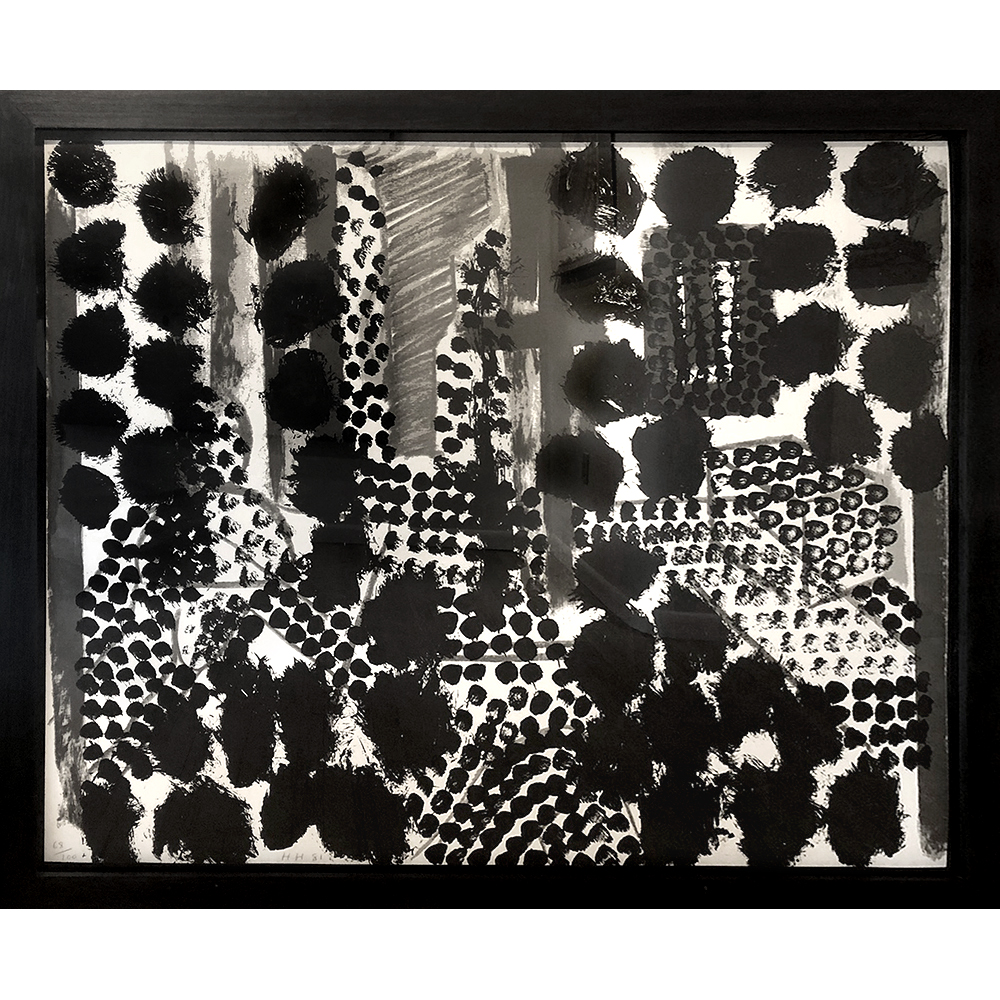Artwork Description
Howard Hodgkin – Souvenir
Dimensions: 52 x 62″ framed / 44.5 x 54.5″ unframed
Year: 1981
Medium: screenprint on Arches aquarelle mould-made paper
Edition: 68/100
Souvenir by Howard Hodgkin (b.1932- d. 2017). Screenprint on Arches aquarelle mould-made paper. Signed by the artist with initials and dated 81 in pencil lower center, numbered in pencil lower left.
This bold Howard Hodgkin print layers five shades of black, with a wide variety of marks including some from the artist’s fingerprints and hand. Scribbles and lines of grey loosely define what could be an interior space with furniture. As is typical of his prints, there is a sense of space, and of the passage of time, expressed through shapes that seem to recede through the picture, deep black shades and, unusually for Hodgkin’s work, the white of the paper showing through.
Catalogue reference: Elizabeth Knowles, Howard Hodgkin: Prints 1977 to 1983, Tate Gallery, London 1985, no. 34 illustrated
Liesbeth Heenk, Howard Hodgkin Prints: A Catalogue Raisonné, Thames and Hudson, London 2003, no. 64 illustrated.
A copy of this print is in the collections of Tate, London; British Council, London; St. Anne’s College, Oxford; and National Galleries Scotland, Edinburgh.
Howard Hodgkin (1932-2017) was born in Hammersmith, London. After spending three years in America during the Second World War and engaging with works in the Museum of Modern Art by the likes of Henri Matisse, Édouard Vuillard, and Pierre Bonnard, he returned to Britain adamant to be an artist. Having run away from both Eton College and Bryanston School, he eventually attended Camberwell School of Arts and Crafts (1949-50) and Bath Academy of Art in Corsham (1950-54).
The emotional nature of Hodgkin’s work and his distinctive abstract mark-making helped to set him apart from other movements such as Pop Art, hard abstraction and the School of London which proliferated during the 1960s. Throughout his career his highly distinctive style of painting and singular vision made him difficult to categorise, undoubtedly causing some frustration to critics and historians along the way.
His first solo exhibition was at Arthur Tooth & Sons in London in 1962. Two years later he visited India for the first time following his interest in Indian miniatures, and this was to be the start of a profound relationship with the country he would come to visit regularly throughout his life.
Having gained wide-spread recognition in the 1960s and 1970s, Hodgkin’s career exploded in the 1980s. In 1984 he represented Britain at the Biennale di Venezia. His exhibition Forty Paintings reopened the Whitechapel Gallery, London, in 1985, and he won the Turner Prize the same year. He has had museum exhibitions at venues across the world including the Metropolitan Museum of Art; the Hayward Gallery, London; Museo Nacional Centro de Arte Reina Sofía, Madrid; National Portrait Gallery, London; Modern Art Museum of Fort Worth, Texas; Kunstverein für die Rheinlande und Westfalen, Düsseldorf and the Irish Museum of Modern Art, Dublin.
Hodgkin was knighted in 1992 and made a Companion of Honour in 2003. He was awarded the Shakespeare Prize in Hamburg in 1997, and in 2014 won the first Swarovski Whitechapel Gallery Art Icon award.

